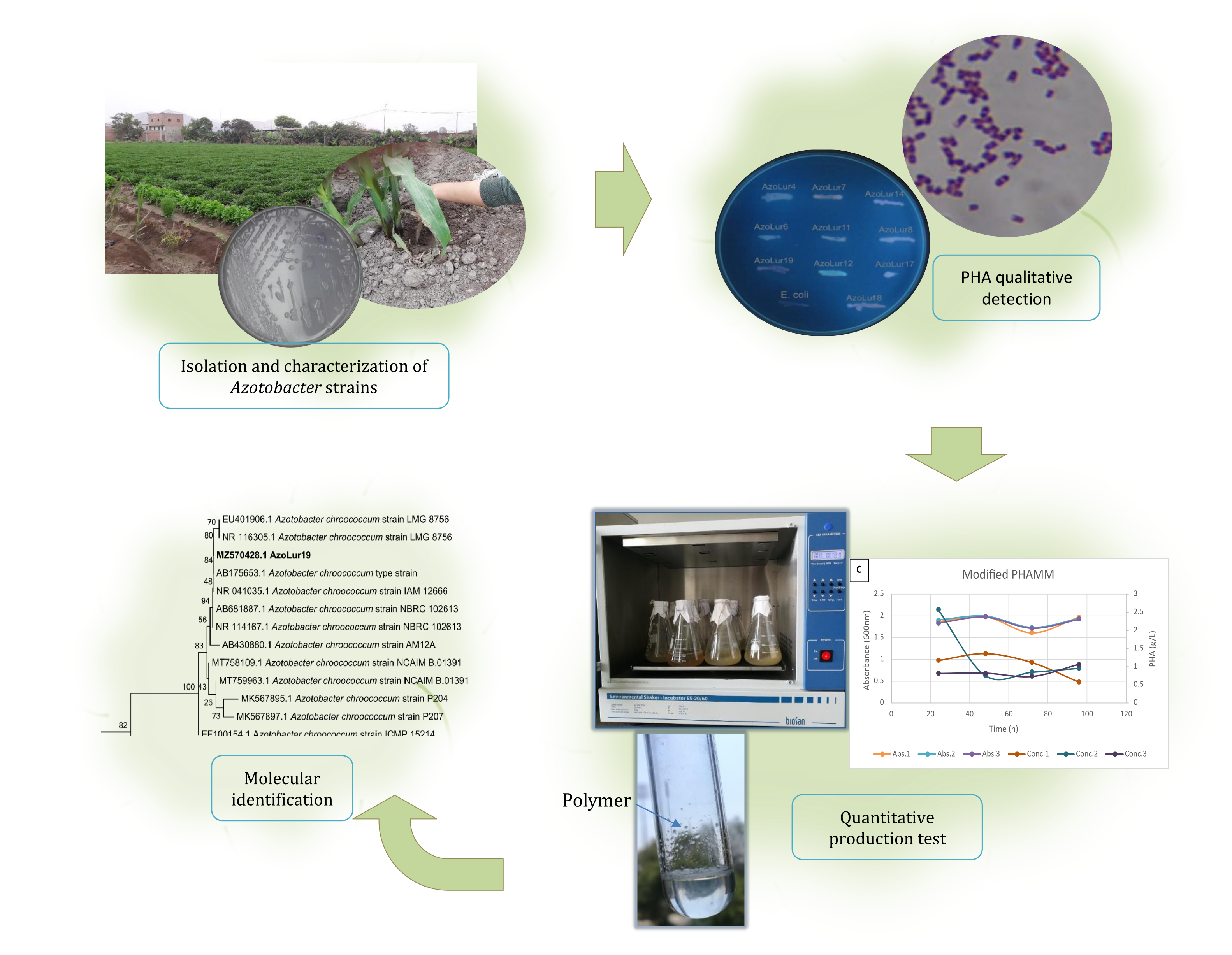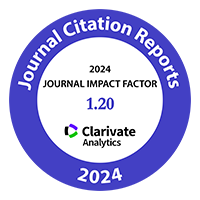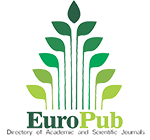Isolation of Polyhydroxyalkanoate (PHA)-producing Azotobacter spp. from Crop Rhizospheres located in Lima, Peru
Palabras clave:
Azotobacter, polihidroxialcanoato , producción de PHA, bioplásticosResumen

PHAs are polyesters found as internal granules in several microorganisms. Azotobacter is known for its ability to produce PHA. This study aimed to isolate Azotobacter from the rhizosphere of selected crops located in Lima and evaluate their PHA-producing potential. Nile Red medium was used for PHA detection, and Sudan Black B staining allowed microscopic observation. Biopolymer production and quantification were carried out in Burk’s medium, PHA minimal medium (PHAMM), and modified PHAMM. In Nile Red medium, 68.2% of strains produced PHA, with Azotobacter AzoLur20 exhibiting the highest production, 2.1 g/L of PHA at 96 hours in PHAMM. However, strain AzoLur19 showed higher productivity and stability, achieving 0.06 g/L*h of PHA. Additionally, Sudan Black B staining in Burk’s medium revealed larger Azotobacter cells with more defined granules. AzoLur19 was classified as Azotobacter chroococcum. In conclusion, Azotobacter species isolated from crops located in Lima can produce PHA with high yields, with A. chroococcum as the predominant species.
Highlights:
- A total of 22 Azotobacter strains were isolated, with A. chroococcum AzoLur19 identified as a promising PHA producer.
- PHA accumulation was successfully screened using Nile Red and Sudan Black B staining methods.
- AzoLur20 and AzoLur23 achieved high PHA yields, with up to 87.67% accumulation in Burk medium.
- AzoLur19 strain reached the highest productivity (0.06 g/L·h) in both PHAMM and modified PHAMM media.
- Modified PHAMM medium showed potential as an alternative for efficient PHA biosynthesis.
Descargas
Citas
Aasfar, A.; Bargaz, A.; Yaakoubi, K.; Hilali, A.; Bennis, I.; Zeroual, Y.; Kadmiri, I. 2021. Nitrogen Fixing Azotobacter Species as Potential Soil Biological Enhancers for Crop Nutrition and Yield Stability. Frontiers in Microbiology. 12: 1-19.
Altschul, S.; Madden, T.; Schaffer, A.; Zhang, J.; Zhang, Z.; Miller, W.; Lipman, D. 1997. Gapped BLAST and PSI- BLAST: a new generation of protein database search programs. Nucleic Acids Research. 2(17): 3389-3402.
Arsita, R.; Karim, H.; Hala, Y.; Iriany, N.; Jumadi, O. 2020. Isolation and identification of nitrogen-fixing bacteria in the corn rhizosphere (Zea mays L.) originating from Jeneponto Regency, South Sulawesi. IOP Conf. Series: Earth and Environmental Science. 484: 012051.
Becerra, M. 2013. Producción de un polímero tipo polihidroxialcanoato (PHA) empleando residuos de la producción de biodiesel. Tesis de Magister en Ciencias, Microbiología. Facultad de Ciencias. Universidad Nacional de Colombia. Bogotá. Colombia. 129 p.
Carballo, M.; Iglesias, Y.; Martínez, J.; Solano, R.; Fernández, A.; Villaverde, M. 2003. Evaluación de la producción de polihidroxialcanoatos por cepas bacterianas marinas. Revista Biología. 17(1): 52-57.
Castillo, C.; Flores, C.; Segura, D.; Espín, G.; Sanguino, J.; Cabrera, E.; Barreto, J.; Díaz, A.; Peña, C. 2017. Production of polyhydroxybutyrate (PHB) of high and ultra-high molecular weight by Azotobacter vinelandii in batch and fed-batch cultures. Journal of Chemical Technology & Biotechnology. 92: 1809-1816.
Cerrone, F. 2011. Producción de poliésteres biopoliméricos (PHAs) desde alpeorujo por medio de bacterias fijadoras de nitrógeno. Tesis doctoral, Doctorado europeo. Instituto del agua. Universidad de Granada. Granada. España. 152 p.
Chávez, M. 2021. Metabolitos de Azotobacter spp. con posible aplicación biotecnológica. Tesis de grado en Biología. Facultad de Ciencias Biológicas. Benemérita Universidad Autónoma de Puebla. Puebla. México. 108 p.
El-Nahrawy, S.; El-Kodoos, R.; El-Sayed, B.; El-Shouny, W. 2018. Production of Poly-β-hydroxybutyrate (PHB) by Azotobacter sp. Isolated from Different Sources. Environmental Biodiversity and Soil Security. 2: 183-192.
Escobar, C.; Horna, Y.; Carreño, C.; Mendoza, G. 2011. Caracterización de cepas nativas de Azotobacter spp. y su efecto en el desarrollo de Lycopersicon esculentum Mill. “tomate” en Lambayeque. Scientia Agropecuaria. 2(1): 39-49.
Gatea, I.; Sabr, A.; Abdul, E.; Abbas, A.; Halob, A.; Mahmood, M. 2019. Isolation and characterization of local Azotobacter isolate producing bio-plastics and consuming waste vegetable oils. IOP Conf. Series: Earth and Environmental Science. 388: 012082.
Giraldo, J.; Castaño, G.; Rivera, F. 2020. Bacteria from industrial waste: potencial producers of polyhydroxyalkanoates (PHA’s) in Manizales, Colombia. Environmental Monitoring and Assessment. 192(7): 480.
Kim, B.; Chang, H. 1998. Production of poly(3-hydroxybutyrate) from starch by Azotobacter chroococcum. Biotechnology Letters. 20(2): 109-112.
Lara, C.; García, L.; Oviedo, L. 2010. Medio de cultivo utilizando residuos-sólidos para el crecimiento de una bacteria nativa con potencial biofertilizante. Revista Colombiana de Biotecnología, 12(1): 103-112.
Malynovska, I.; Yula, V.; Asanishvili, N.; Ptashnik, М.; Lyubchich, A. 2021. Influence of crop species on quantity and physiological activity of rhizosphere microorganisms. Ukrainian Journal of Ecology, 11(1): 286-290.
Martinez, M.; Gonzalez, J.; Rodelas, B.; Pozo, C.; Salmeron, V. 1995. Production of poly- β-hydroxybutyrate by Azotobacter chroococcum H23 in chemically defined medium and alpechin médium. Journal of Applied Bacteriology. 78: 413-418.
McAdam, B.; Brennan, M.; Mcdonal, P.; Mojicevic, M. 2020. Producción de polihidroxibutirato (PHB) y factores que afectan sus características químicas y mecánicas. Polímeros. 12(12): 2908.
Mohammed, S.; Panda, A.; Ray, L. 2019. An investigation for recovery of polyhydroxyalkanoates (PHA) from Bacillus sp. BPPI-14 and Bacillus sp. BPPI-19 isolated from plastic waste landfill. International Journal of Biological Macromolecules. 134: 1085-1096.
Navia Porras, D. P.; Poveda Perdomo, L. G.; Cuervo Mulet, R. A.; Esparza Estrada, J.; Hernández Umaña, J. 2024. Antibacterial activity and physicochemical characterization of bioplastic films based on cassava (Manihot esculenta Crantz) starch and rosemary (Salvia rosmarinus) essential oil. Revista de la Facultad de Ciencias Agrarias. Universidad Nacional de Cuyo. Mendoza. Argentina. 56(2): 126-136. DOI: https://doi.org/10.48162/rev.39.136
Pei, M.; Kumar, S.; Woan, L.; Bor, J.; Najimudin, N. 2017. Characterization of polyhydroxyalkanoate production by mutant Azotobacter vinelandii. Malaysian Applied Biology. 46(1): 1-8.
Ramírez, M. E.; Herrera, S. L.; Domínguez, M.; Romo, Á.; Segura, D.; Peña, C. 2011. Evaluación de la producción y peso molecular del polihidroxibutirato (PHB) sintetizado por diversas cepas mutantes de A. vinelandii. Sociedad Mexicana de Bioquímica, Congreso Nacional 2011. Querétaro. Cartel CV-68.
Ramos, A. 2019. Extracción, purificación y modificación de un biopolímero del tipo poli (3-hidroxibutirato) obtenido de la fermentación de ácidos grasos con B. cepacia. Tesis de Maestría en Ingeniería Química. Facultad de Ingeniería. Universidad Nacional de Colombia. Bogotá. Colombia. 192 p.
Sharma, V.; Sehgal, R.; Gupta, R. 2021. Polyhydroxyalkanoate (PHA): Properties and Modifications. Polymer, 212: 123161.
Tamura, K.; Stecher, G.; Kumar, S. 2021. MEGA11: Molecular Evolutionary Genetics Analysis Version 11, Molecular Biology and Evolution. 38(7): 3022-3027.
Vega, O. 2016. Extracción y caracterización estructural de un PHA, obtenido de residuos de cáscaras de yuca y piña mediante procesos de fermentación; y su aplicación en la fabricación de fibras por electrospinning. Tesis de doctor en Ingeniería. Facultad de Ingeniería. Universidad de Antioquia. Medellín. Colombia. 163 p.
Villota-Calvachi, G.; González, K.; Marulanda, S.; Galeano, N.; Velasco, D.; Ocampo, L.; Castañeda, L.; Giraldo, C.; Rodríguez, N. 2022. Aislamiento y caracterización de bacterias productoras de biopolímeros a partir de efluentes industriales. Revista Colombiana de Biotecnología. 24(1): 27-45.
Zambrano, H.; Riera, M. 2021. Desafío de los polihidroxialcanoatos como solución al problema de los plásticos de un solo uso. Publicaciones en Ciencia y Tecnología. 15(1): 15-26.

Descargas
Publicado
Cómo citar
Número
Sección
Licencia
Derechos de autor 2018 Revista de la Facultad de Ciencias Agrarias UNCuyo

Esta obra está bajo una licencia internacional Creative Commons Reconocimiento-NoComercial-CompartirIgual 3.0.
Aquellos autores/as que tengan publicaciones con esta revista, aceptan las Políticas Editoriales.












.jpg)




